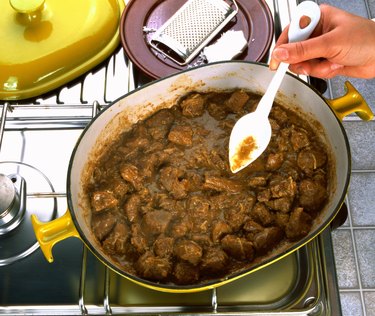
Tough and in need of moisture just like its native desert habitat, camel meat needs at least several hours of moist heat to temper its gaminess and soften its texture. Once you break down the connective tissue and render its fat, though, you're left with a sweet taste akin to veal that fits seamlessly with a flavor profile built with pungent and bold spices. You have to braise camel meat on the stove or in the oven to make it palatable, but you can sear it on the grill first to give it a smoky, charred flavor.
Step 1
Sear the camel meat on the grill or in an oiled heavy pan or Dutch oven on the stovetop. Since you have to braise camel low and slow, you have to sear it hard and early. Whether you're searing the camel on the grill or in a pan, first season it liberally with kosher salt and freshly ground black pepper and coat it with olive oil. Next, heat up the pan or the grill using medium-high heat and sear the camel on all sides until brown and crusted, about 5 to 7 minutes total, turning occasionally.
Video of the Day
Step 2
Saute a few cups of chopped root vegetables, alliums and the aromatic ingredient of your choice in a Dutch oven on the stove for the camel braise. Carrots and parsnips, onions or leeks, and celeriac, stalk celery or fennel bulb support the camel with the floral notes it needs to develop a well-rounded flavor and aroma. Use medium heat and oil, ghee or clarified butter to cook the vegetables until the alliums turn translucent, or for about 5 minutes.
Step 3
Add pungent ingredients to the aromatics and saute until fragrant, about 3 minutes. This is the step in which you begin to build a flavor profile for the camel and have a chance to highlight the subtleties in its aroma and taste. Pungents to choose from include: minced garlic, smashed ginger, chives, shallots, horseradish root and chili peppers, to name a few.
Step 4
Lower the heat on the stove to low and add dried and whole spices to the Dutch oven. Low heat and fat aromatizes the oils and esters in herbs and dried spices, better than if you just add them to the braising liquid cold. You can use bold ingredients here, so think black, red and white peppercorns, Turkish bay leaves, allspice berries, turmeric, curry powder, smoked paprika, crushed cinnamon sticks and star anise. Cook the spices for 2 or 3 minutes.
Step 5
Set the heat to medium-high and cook until you hear sizzling and popping, then pour about a cup of room-temperature acidic dry wine in the pan. Scrape the bottom with a spoon to dislodge the spices and other caramelized bits of food.
Step 6
Place the camel meat in the Dutch oven and add a combination of stock and wine, using enough to cover it by about 3/4. Let the liquid reach a simmer, then lower the heat to Low and cover with a lid.
Step 7
Braise the camel on the stove over low heat or in a 250-degree-Fahrenheit oven. It doesn't matter which you choose, but you can expect to braise the camel for about 4 hours; if you need the stove space, the oven is the best choice.
Step 8
Check the camel every 1 to 1 1/2 hours. If the liquid looks low, add enough water to reach halfway up the sides of the camel. Turn the camel over in the liquid every time you check it.
Step 9
Taste the cooking liquid after 1 1/2 hours and add a secondary flavoring ingredient, an acid, and lightly season with salt. Soy sauce and Worcestershire fit into the camel flavor profile, as do chopped tomatoes, mirin and flavored vinegar, such as rice wine.
Step 10
Check the camel's tenderness after 4 hours using a fork; the camel should pull apart effortlessly. If it doesn't, add liquid as needed and braise an additional 30 minutes to 1 hour.
Step 11
Transfer the camel to a plate and strain out the vegetables and spices from the liquid using a mesh or slotted spoon. Skim all but about 2 tablespoons of the camel fat from the cooking liquid. Increase the heat to medium-high and take the cover off the pan.
Step 12
Simmer the camel cooking liquid until it reduces by 1/2 to 3/4. Cut the camel into 1 1/2-inch pieces and return it to the pan. Coat the camel meat with the glaze and serve.
Things You'll Need
Heavy pan or Dutch oven
Oil
Root vegetables, such as carrots or parsnips
Alliums, such as leeks or onions
Aromatic vegetables, such as fennel or celeriac
Pungent ingredients, such as ginger
Dried spices and whole spices, such as curry powder and allspice berries
Dry wine
Stock
Secondary flavoring ingredient, such as soy sauce or rice wine vinegar
Video of the Day